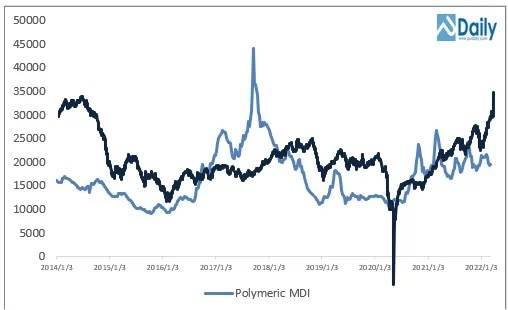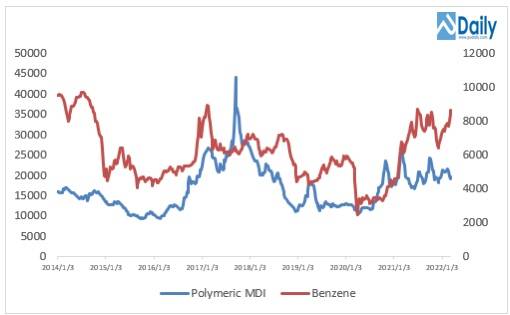How Oil Price Fluctuation Impact on PU Materials Prices
Many market participants wondered how the recent wild fluctuations in oil prices would impact prices of polyurethane raw materials.
WTI, also known as Texas light sweet, serves as a benchmark crude, or subject matter, for U.S. crude futures. Crude futures pricing is based on the benchmark crude in major oil producing regions. For example, WTI serves as the benchmark crude for crude futures traded on New York Futures Exchange. WTI is used as a benchmark crude for pricing all crude produced or sold in the United States.
The figure below compares the movement patterns of WTI crude prices and polymeric MDI prices from 2014 to March 11, 2022 (the dark black line represents WTI crude prices). As can be seen from the figure, there is no obvious correlation between the two prices, and the fluctuation in polymeric MDI price was smaller than that in WTI crude price except in 2017. Besides, the recent surge in oil prices had a limited impact on the movement of domestic polymeric MDI price.
 Next, we will examine how the movement of benzene and rigid polyols prices impact that of polymeric MDI price.
Next, we will examine how the movement of benzene and rigid polyols prices impact that of polymeric MDI price.
Crude oil is used to manufacture naphtha through atmospheric and vacuum distillation, which is then used to make benzene through catalytic reforming. Benzene is used by MDI manufacturers as a main raw material for producing MDI through phosgene process.
WTI, also known as Texas light sweet, serves as a benchmark crude, or subject matter, for U.S. crude futures. Crude futures pricing is based on the benchmark crude in major oil producing regions. For example, WTI serves as the benchmark crude for crude futures traded on New York Futures Exchange. WTI is used as a benchmark crude for pricing all crude produced or sold in the United States.
The figure below compares the movement patterns of WTI crude prices and polymeric MDI prices from 2014 to March 11, 2022 (the dark black line represents WTI crude prices). As can be seen from the figure, there is no obvious correlation between the two prices, and the fluctuation in polymeric MDI price was smaller than that in WTI crude price except in 2017. Besides, the recent surge in oil prices had a limited impact on the movement of domestic polymeric MDI price.

Crude oil is used to manufacture naphtha through atmospheric and vacuum distillation, which is then used to make benzene through catalytic reforming. Benzene is used by MDI manufacturers as a main raw material for producing MDI through phosgene process.
The figure below shows that the movement of benzene price is more closely correlated with that of polymeric MDI price than that of WTI crude prices, especially during the period before 2017. After 2017, as new MDI capacities in China were put into production gradually, other factors played increasingly roles in determining the movement of polymeric MDI price, especially the dynamics of supply and demand.

 English
English  日本語
日本語  ภาษาไทย
ภาษาไทย  한국어
한국어  العربية
العربية  Latine
Latine  Español
Español  Português
Português  русский
русский  Français
Français  Deutsch
Deutsch  tiếng Việt
tiếng Việt  Italiano
Italiano  Nederlands
Nederlands  Polski
Polski  Svenska
Svenska  magyar
magyar  Malay
Malay  বাংলা ভাষার
বাংলা ভাষার  Dansk
Dansk  Suomi
Suomi  हिन्दी
हिन्दी  Pilipino
Pilipino  Türkçe
Türkçe  Gaeilge
Gaeilge  Indonesia
Indonesia  Norsk
Norsk  تمل
تمل  český
český  ελληνικά
ελληνικά  український
український  Javanese
Javanese  فارسی
فارسی  தமிழ்
தமிழ்  తెలుగు
తెలుగు  नेपाली
नेपाली  Burmese
Burmese  български
български  ລາວ
ລາວ  Қазақша
Қазақша  Euskal
Euskal  Azərbaycan
Azərbaycan  Slovenský jazyk
Slovenský jazyk  Македонски
Македонски  Lietuvos
Lietuvos  Eesti Keel
Eesti Keel  Română
Română  Slovenski
Slovenski  मराठी
मराठी  Srpski језик
Srpski језик 


